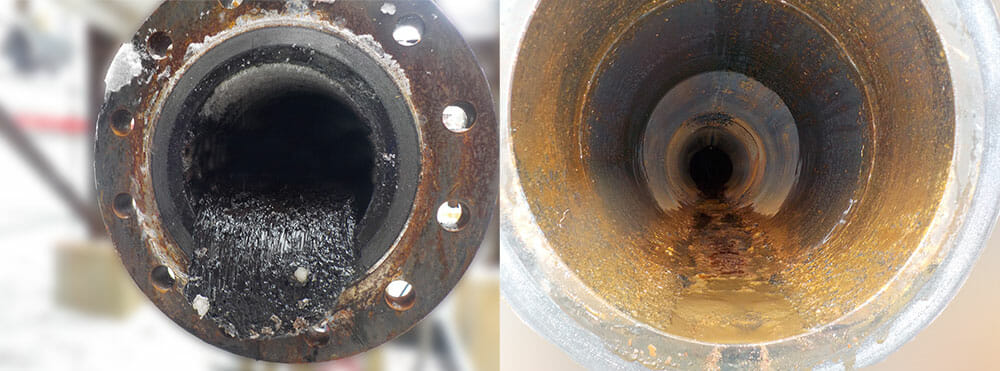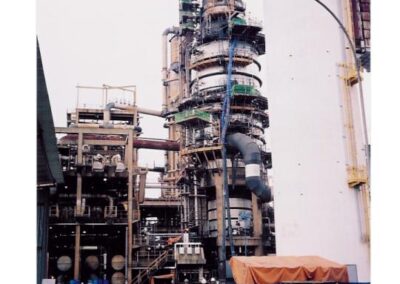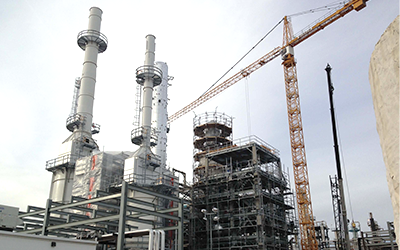Case History
SAGD Oil Sands facility saves $350,000 dollars and reduces mechanical cleaning costs by 50% utilizing FQE® Solvent-ME
Results Achieved
Plant fully decontaminated
of bitumen residue
$350,000 saved by eliminating cutter stock requirement
Reduced mechanical cleaning costs and timelines by over 50%
Chemicals Utilized
Water-based degreaser for dissolving high mole organics
Scope of Work
Group 1: Vessels
- SUCS Separator for WP 1
- SUCS K.O. Drum for WP 1
- SUCS Separator for WP 2
- SUCS K.O. Drum for WP 2
- Inlet Surge Vessel
[/et_pb_divi_atm]
Group 2: Piping
- Flow Lines from WP-1
- Flow Lines from WP-2
- SUCS Piping at WP-1
- SUCS Piping at WP-2
- PE Lines from WP-1 to Super Module 1
- PE Lines from WP-1 to Super Module 2
- PE Lines from WP-2 to Super Module 1
- PE Lines from WP-2 to Super Module 2
- PE Lines from WP-2 to Super Module 3
- SGF Area Piping
[/et_pb_divi_atm]
Group 3: Exchangers
- 6 Produced Emulsion / BFW Exchanger
- 3 Produced Emulsion / Glycol Exchanger
- Ejector Vapor Knock-out Drum
[/et_pb_divi_atm]
Group 4: Components
- Drop Out Spools
[/et_pb_divi_atm]
A SAGD oil sands facility, located in Northern Alberta used FQE Solvent-ME to remove ultra-high viscosity bitumen residue from piping, vessels and pumps.

Oil sands are a mixture of bitumen, sand, water, and clay. The primary characteristic of bitumen is its inability to flow and therefore it cannot be produced using traditional means. Common production methods include open pit mining and steam assisted in-situ processes. The characteristics of bitumen found in Alberta — and with outside temperatures between -4°F to -40°F (-20°C to -40°C) — make it challenging for decontamination projects in the oil sands.
The client needed to effectively decontaminate a Steam Assisted Gravity Drainage (SAGD) facility for long-term preservation. The scope of work included two Well Pads (WPs) consisting of 37 well pairs and associated Produced Emulsion (PE) lines, five Well Pad Super Modules, two Start-Up Circulation Systems (SUCS) (a separator and knockout drum each), Steam Generation Facility Emulsion System (SGF), and approximately 1.2 miles (2 kilometer) of produced emulsion flow line that connects the well pads and the production facility.
After rigorous lab testing comparing several alternatives, FQE Solvent-ME was selected as the most effective and viable option. Developed to temporarily tie into water, FQE Solvent-ME eliminated the requirement for large volumes of expensive cutter stock (unavailable at the SAGD facility), and the need to conduct a final chemical degrease wash, as all surfaces were left water wet.
FQE Solvent-ME was applied using a variety of techniques:
1
Liquid Circulation
Process piping, produced emulsion line to the pads
2
High Pressure Jetting
Vessels and drums
3
Fill and Soak
Rotative equipment, including pump casings
The largest scope of work was a 1.2 mile (2 kilometer) produced emulsion line. The line was coupled with the parallel line flushed in a full flushing loop. Employing continuous heating and circulation of FQE Solvent-ME yielded residue free flow lines.
To put the chemical effectiveness in perspective, FQE Solvent-ME dissolved the high asphaltenic bitumen residue and brought it into a flowable liquid solution.
Summary of Results
Utilizing FQE Solvent-ME provided significant cost savings to the client since they did not have to procure a large amount of expensive cutter stock. This also diminished the need to conduct a final chemical degrease wash, as all surfaces were left water wet.
Upon completion of the scope, the client quality inspectors — utilizing thorough borescope inspections — accepted the chemical cleaning results. High viscosity bitumen residue on equipment, vessels and piping was eliminated and the mechanical asset integrity was maintained.



